

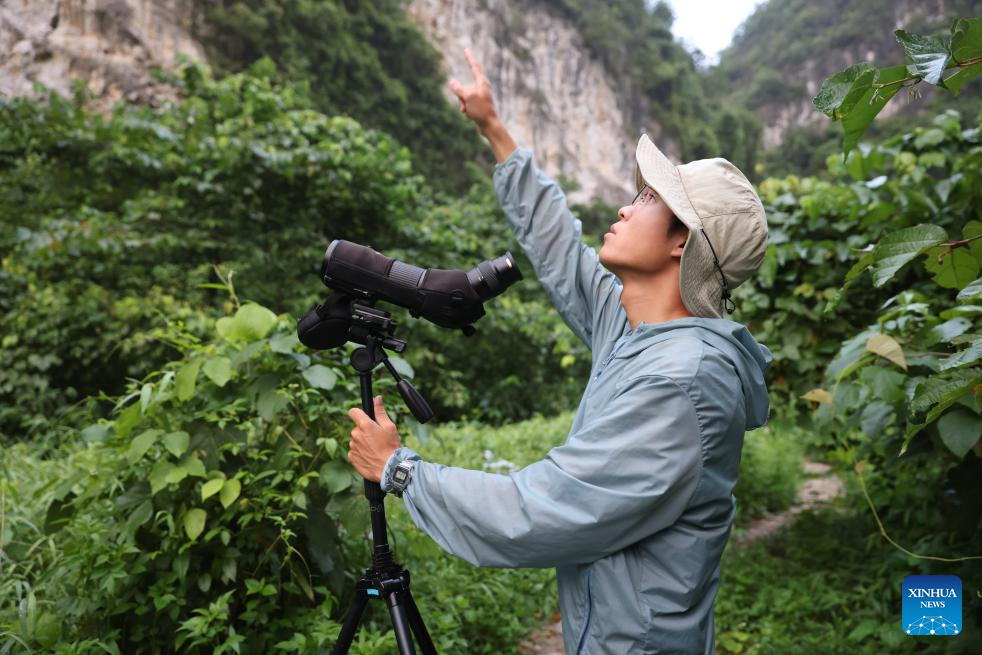
Researcher Li Wenqin points to where white-headed langurs appear at a national nature reserve in Luobai Town of Jiangzhou District, Chongzuo City, south China's Guangxi Zhuang Autonomous Region, Aug. 5, 2023. China's white-headed langur is one of the world's most endangered primate species. Characterized by the white hair on their heads, the animals are spotted in less than 200 square km karst hills between the Zuojiang and Mingjiang rivers in Chongzuo.
In recent years, in order to better protect the white-headed langur, patrolling and technological measures including infrared cameras and remote monitoring have been applied to track and monitor them around the clock. The latest figures show that the population of white-headed langurs has increased to about 1,400 thanks to a group of guardians who dedicate themselves to protecting those "elves" in spite of many difficulties. (Xinhua/Li Mengxin)
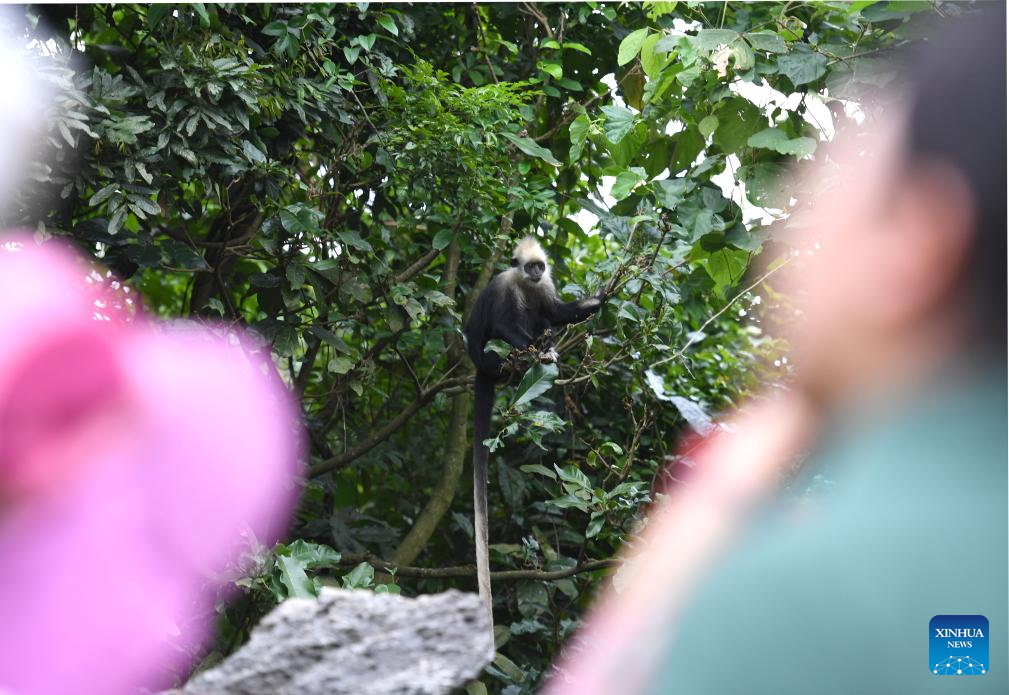
Tourists view a white-headed langur at a national nature reserve in Luobai Town of Jiangzhou District, Chongzuo City, south China's Guangxi Zhuang Autonomous Region, Aug. 5, 2023. China's white-headed langur is one of the world's most endangered primate species. Characterized by the white hair on their heads, the animals are spotted in less than 200 square km karst hills between the Zuojiang and Mingjiang rivers in Chongzuo.
In recent years, in order to better protect the white-headed langur, patrolling and technological measures including infrared cameras and remote monitoring have been applied to track and monitor them around the clock. The latest figures show that the population of white-headed langurs has increased to about 1,400 thanks to a group of guardians who dedicate themselves to protecting those "elves" in spite of many difficulties. (Xinhua/Zhou Hua)

A white-headed langur climbs on a cliff at a national nature reserve in Luobai Town of Jiangzhou District, Chongzuo City, south China's Guangxi Zhuang Autonomous Region, Aug. 5, 2023. China's white-headed langur is one of the world's most endangered primate species. Characterized by the white hair on their heads, the animals are spotted in less than 200 square km karst hills between the Zuojiang and Mingjiang rivers in Chongzuo.
In recent years, in order to better protect the white-headed langur, patrolling and technological measures including infrared cameras and remote monitoring have been applied to track and monitor them around the clock. The latest figures show that the population of white-headed langurs has increased to about 1,400 thanks to a group of guardians who dedicate themselves to protecting those "elves" in spite of many difficulties. (Xinhua/Zhou Hua)
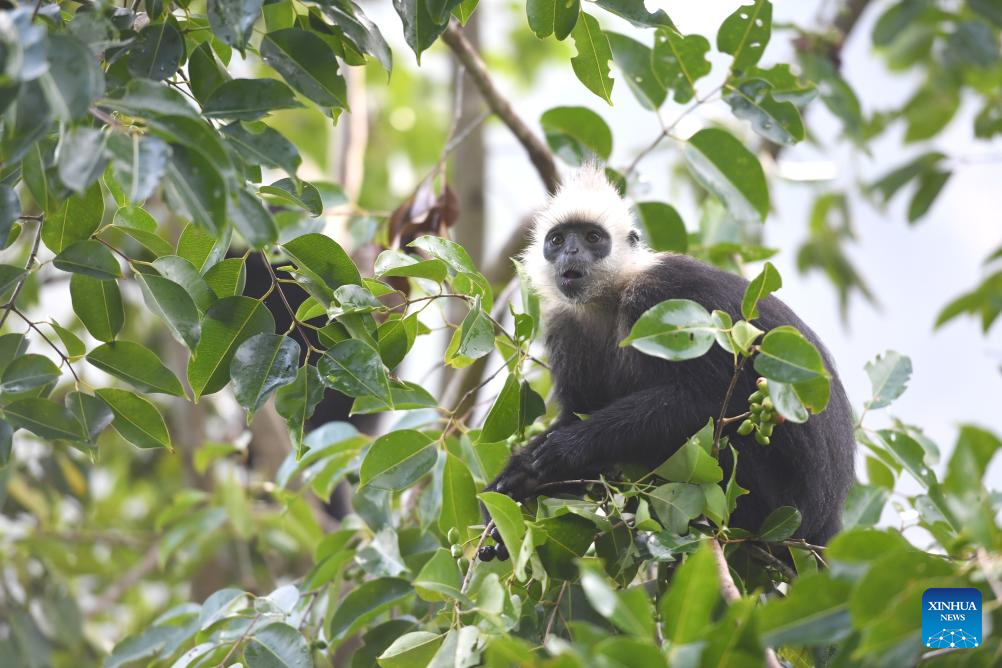
A white-headed langur forages at a national nature reserve in Luobai Town of Jiangzhou District, Chongzuo City, south China's Guangxi Zhuang Autonomous Region, Aug. 5, 2023. China's white-headed langur is one of the world's most endangered primate species. Characterized by the white hair on their heads, the animals are spotted in less than 200 square km karst hills between the Zuojiang and Mingjiang rivers in Chongzuo.
In recent years, in order to better protect the white-headed langur, patrolling and technological measures including infrared cameras and remote monitoring have been applied to track and monitor them around the clock. The latest figures show that the population of white-headed langurs has increased to about 1,400 thanks to a group of guardians who dedicate themselves to protecting those "elves" in spite of many difficulties. (Xinhua/Zhou Hua)
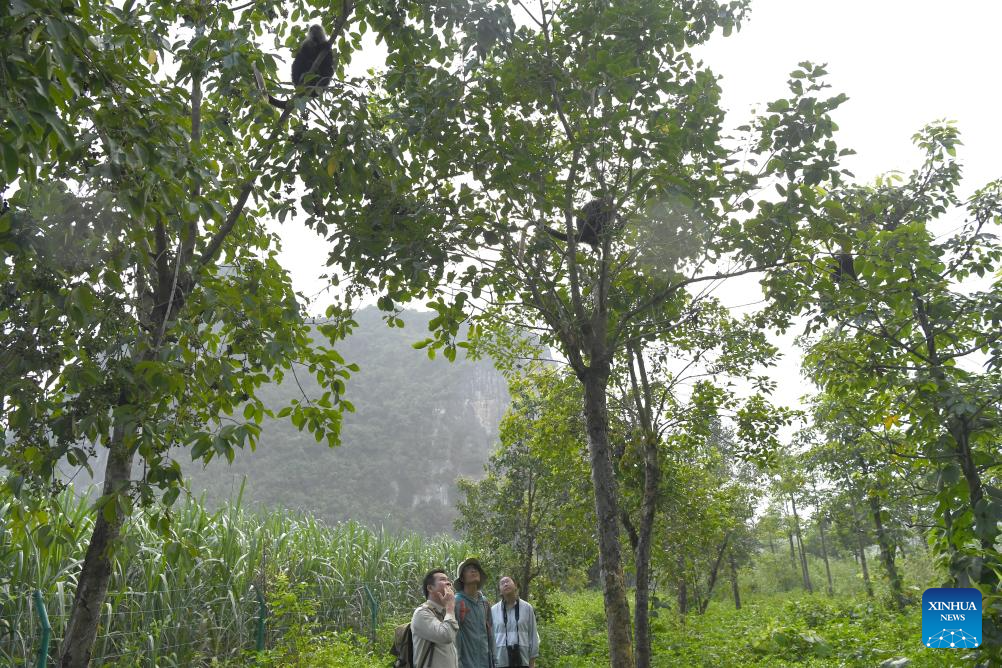
Researcher Li Wenqin (C) and Liu Yanchen and ranger Liang Zhizhang (L) observe white-headed langurs at a national nature reserve in Luobai Town of Jiangzhou District, Chongzuo City, south China's Guangxi Zhuang Autonomous Region, Aug. 5, 2023. China's white-headed langur is one of the world's most endangered primate species. Characterized by the white hair on their heads, the animals are spotted in less than 200 square km karst hills between the Zuojiang and Mingjiang rivers in Chongzuo.
In recent years, in order to better protect the white-headed langur, patrolling and technological measures including infrared cameras and remote monitoring have been applied to track and monitor them around the clock. The latest figures show that the population of white-headed langurs has increased to about 1,400 thanks to a group of guardians who dedicate themselves to protecting those "elves" in spite of many difficulties. (Xinhua/Zhou Hua)
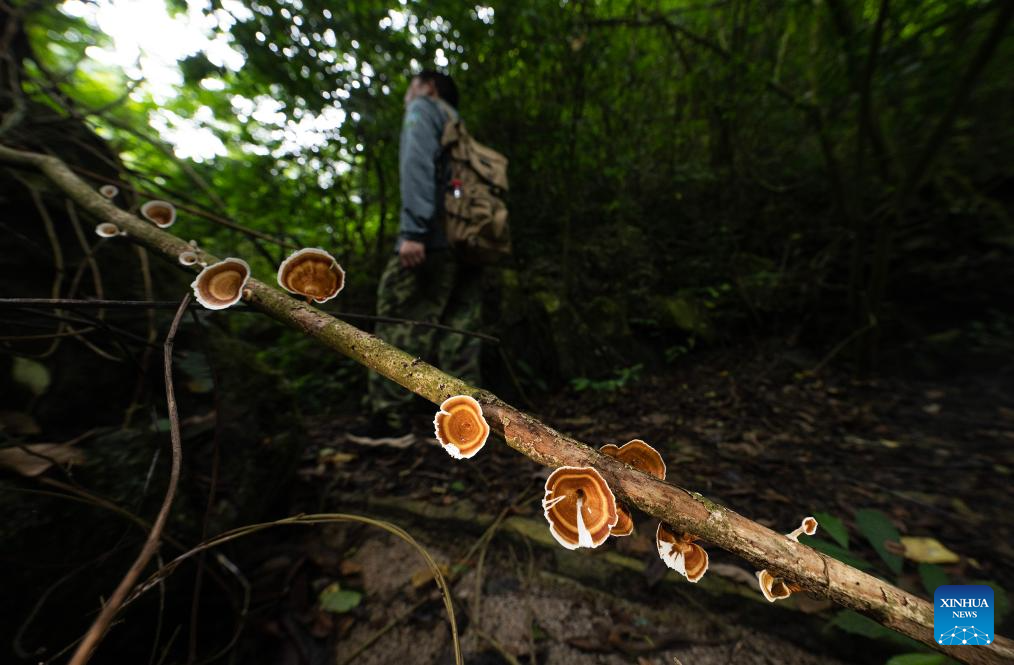
Ranger Liang Zhizhang looks for white-headed langurs during a patrol at a national nature reserve in Luobai Town of Jiangzhou District, Chongzuo City, south China's Guangxi Zhuang Autonomous Region, Aug. 4, 2023. China's white-headed langur is one of the world's most endangered primate species. Characterized by the white hair on their heads, the animals are spotted in less than 200 square km karst hills between the Zuojiang and Mingjiang rivers in Chongzuo.
In recent years, in order to better protect the white-headed langur, patrolling and technological measures including infrared cameras and remote monitoring have been applied to track and monitor them around the clock. The latest figures show that the population of white-headed langurs has increased to about 1,400 thanks to a group of guardians who dedicate themselves to protecting those "elves" in spite of many difficulties. (Xinhua/Fei Maohua)
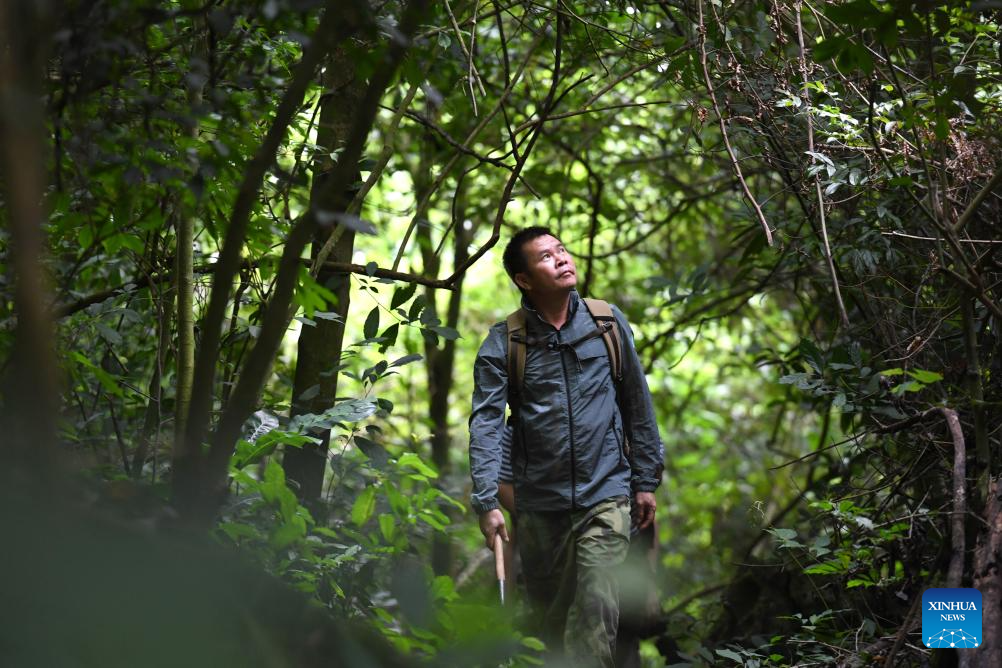
Ranger Liang Zhizhang looks for white-headed langurs during a patrol at a national nature reserve in Luobai Town of Jiangzhou District, Chongzuo City, south China's Guangxi Zhuang Autonomous Region, Aug. 4, 2023. China's white-headed langur is one of the world's most endangered primate species. Characterized by the white hair on their heads, the animals are spotted in less than 200 square km karst hills between the Zuojiang and Mingjiang rivers in Chongzuo.
In recent years, in order to better protect the white-headed langur, patrolling and technological measures including infrared cameras and remote monitoring have been applied to track and monitor them around the clock. The latest figures show that the population of white-headed langurs has increased to about 1,400 thanks to a group of guardians who dedicate themselves to protecting those "elves" in spite of many difficulties. (Xinhua/Zhou Hua)
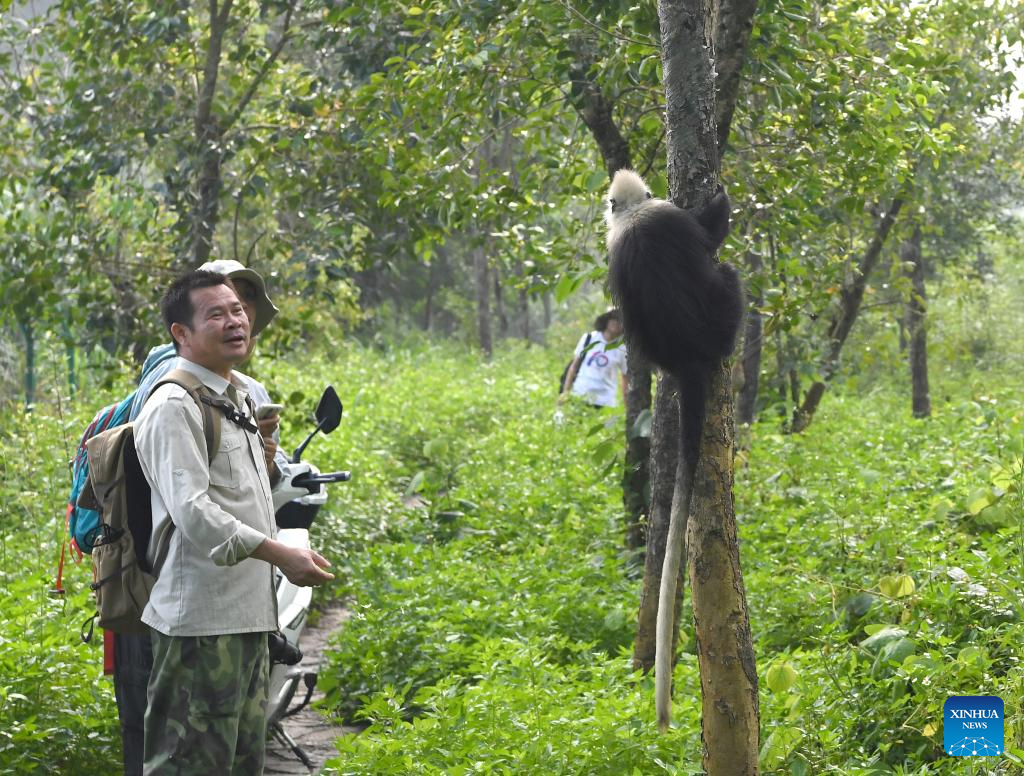
Ranger Liang Zhizhang observes a white-headed langur during a patrol at a national nature reserve in Luobai Town of Jiangzhou District, Chongzuo City, south China's Guangxi Zhuang Autonomous Region, Aug. 5, 2023. China's white-headed langur is one of the world's most endangered primate species. Characterized by the white hair on their heads, the animals are spotted in less than 200 square km karst hills between the Zuojiang and Mingjiang rivers in Chongzuo.
In recent years, in order to better protect the white-headed langur, patrolling and technological measures including infrared cameras and remote monitoring have been applied to track and monitor them around the clock. The latest figures show that the population of white-headed langurs has increased to about 1,400 thanks to a group of guardians who dedicate themselves to protecting those "elves" in spite of many difficulties. (Xinhua/Zhou Hua)
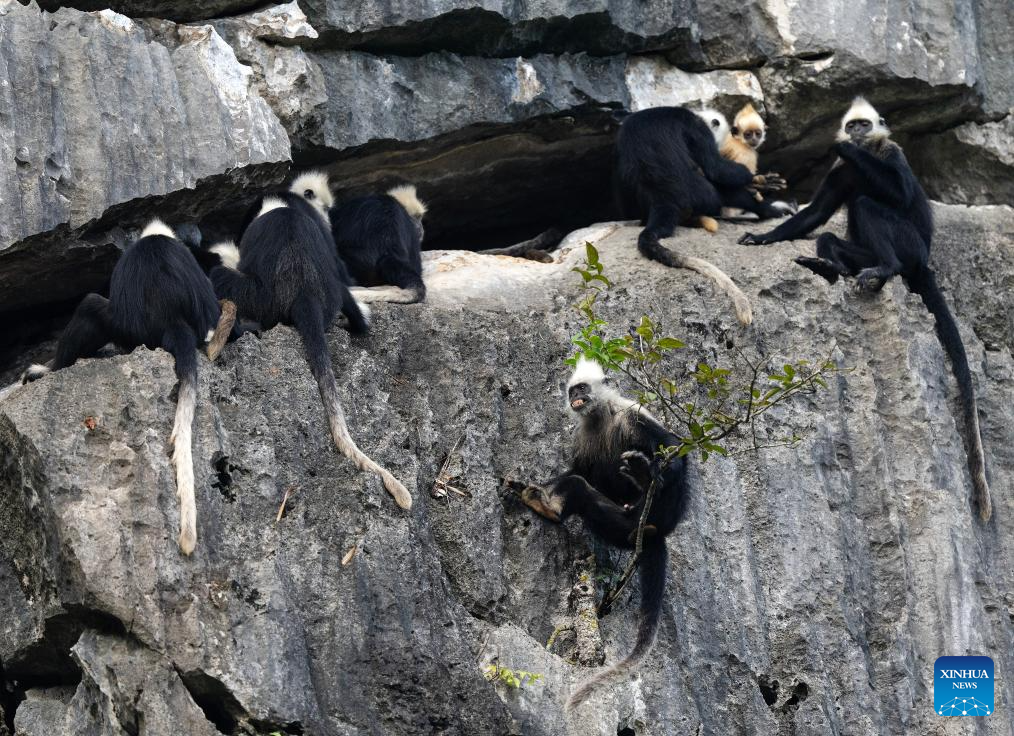
A flock of white-headed langurs rest on a cliff at a national nature reserve in Luobai Town of Jiangzhou District, Chongzuo City, south China's Guangxi Zhuang Autonomous Region, Aug. 5, 2023. China's white-headed langur is one of the world's most endangered primate species. Characterized by the white hair on their heads, the animals are spotted in less than 200 square km karst hills between the Zuojiang and Mingjiang rivers in Chongzuo.
In recent years, in order to better protect the white-headed langur, patrolling and technological measures including infrared cameras and remote monitoring have been applied to track and monitor them around the clock. The latest figures show that the population of white-headed langurs has increased to about 1,400 thanks to a group of guardians who dedicate themselves to protecting those "elves" in spite of many difficulties. (Xinhua/Fei Maohua)

Researcher Li Wenqin (back) and Liu Yanchen observe white-headed langurs at a national nature reserve in Luobai Town of Jiangzhou District, Chongzuo City, south China's Guangxi Zhuang Autonomous Region, Aug. 5, 2023. China's white-headed langur is one of the world's most endangered primate species. Characterized by the white hair on their heads, the animals are spotted in less than 200 square km karst hills between the Zuojiang and Mingjiang rivers in Chongzuo.
In recent years, in order to better protect the white-headed langur, patrolling and technological measures including infrared cameras and remote monitoring have been applied to track and monitor them around the clock. The latest figures show that the population of white-headed langurs has increased to about 1,400 thanks to a group of guardians who dedicate themselves to protecting those "elves" in spite of many difficulties. (Xinhua/Fei Maohua)
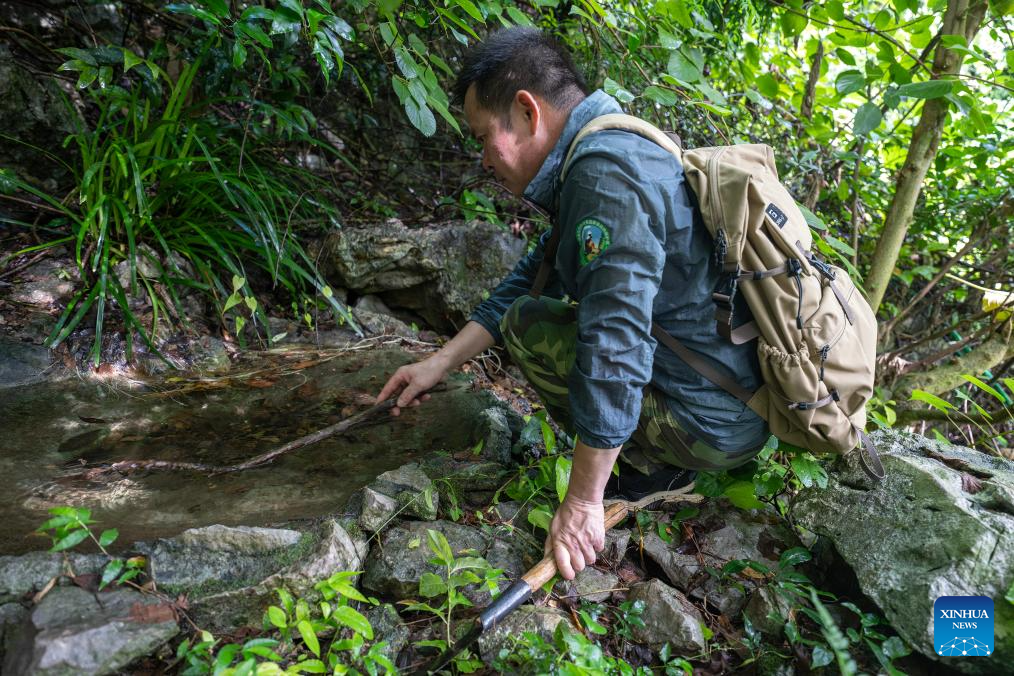
Ranger Liang Zhizhang moves away a tree branch from a watering place made for white-headed langurs during a patrol at a national nature reserve in Luobai Town of Jiangzhou District, Chongzuo City, south China's Guangxi Zhuang Autonomous Region, Aug. 4, 2023. China's white-headed langur is one of the world's most endangered primate species. Characterized by the white hair on their heads, the animals are spotted in less than 200 square km karst hills between the Zuojiang and Mingjiang rivers in Chongzuo.
In recent years, in order to better protect the white-headed langur, patrolling and technological measures including infrared cameras and remote monitoring have been applied to track and monitor them around the clock. The latest figures show that the population of white-headed langurs has increased to about 1,400 thanks to a group of guardians who dedicate themselves to protecting those "elves" in spite of many difficulties. (Xinhua/Fei Maohua)
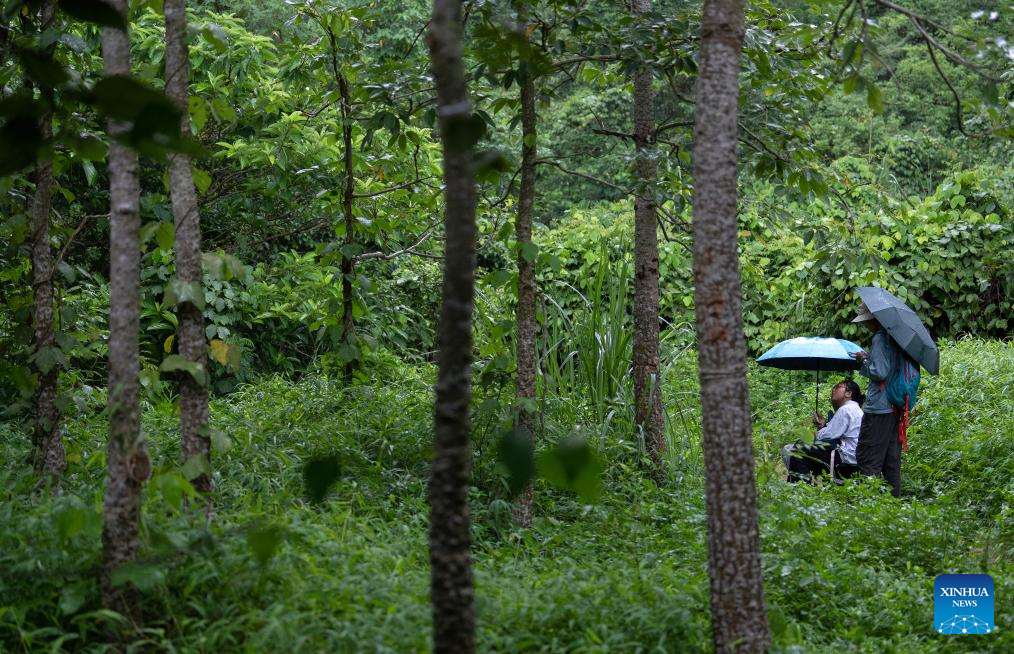
Researcher Li Wenqin (R) and Liu Yanchen wait as they observe white-headed langur at a national nature reserve in Luobai Town of Jiangzhou District, Chongzuo City, south China's Guangxi Zhuang Autonomous Region, Aug. 5, 2023. China's white-headed langur is one of the world's most endangered primate species. Characterized by the white hair on their heads, the animals are spotted in less than 200 square km karst hills between the Zuojiang and Mingjiang rivers in Chongzuo.
In recent years, in order to better protect the white-headed langur, patrolling and technological measures including infrared cameras and remote monitoring have been applied to track and monitor them around the clock. The latest figures show that the population of white-headed langurs has increased to about 1,400 thanks to a group of guardians who dedicate themselves to protecting those "elves" in spite of many difficulties. (Xinhua/Fei Maohua)
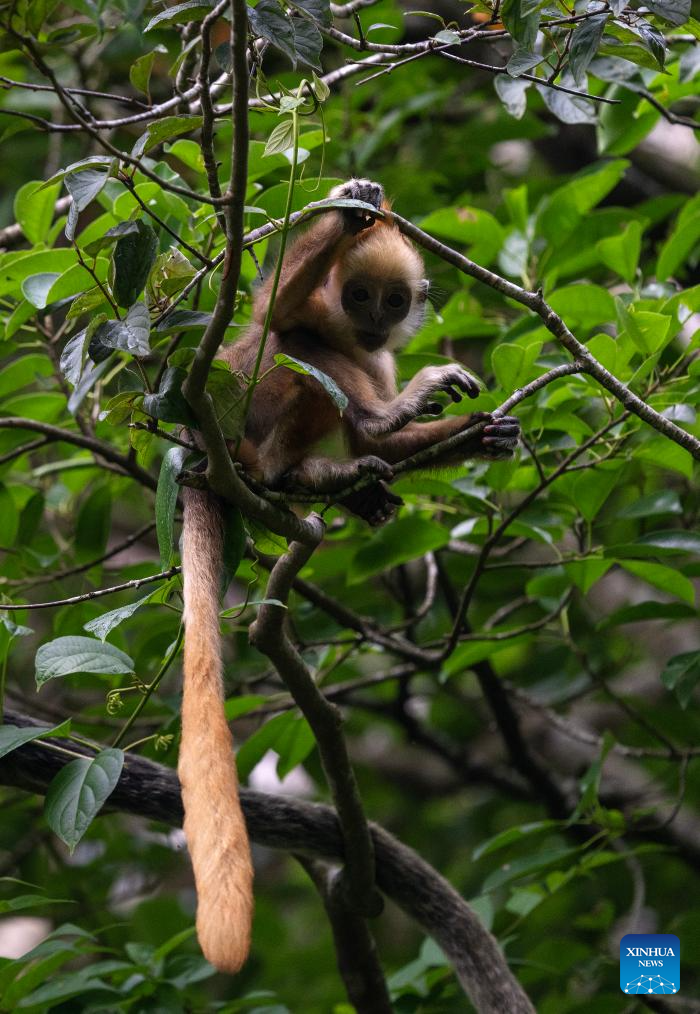
A white-headed langur looks out on a tree branch at a national nature reserve in Luobai Town of Jiangzhou District, Chongzuo City, south China's Guangxi Zhuang Autonomous Region, Aug. 5, 2023. China's white-headed langur is one of the world's most endangered primate species. Characterized by the white hair on their heads, the animals are spotted in less than 200 square km karst hills between the Zuojiang and Mingjiang rivers in Chongzuo.
In recent years, in order to better protect the white-headed langur, patrolling and technological measures including infrared cameras and remote monitoring have been applied to track and monitor them around the clock. The latest figures show that the population of white-headed langurs has increased to about 1,400 thanks to a group of guardians who dedicate themselves to protecting those "elves" in spite of many difficulties. (Xinhua/Fei Maohua)
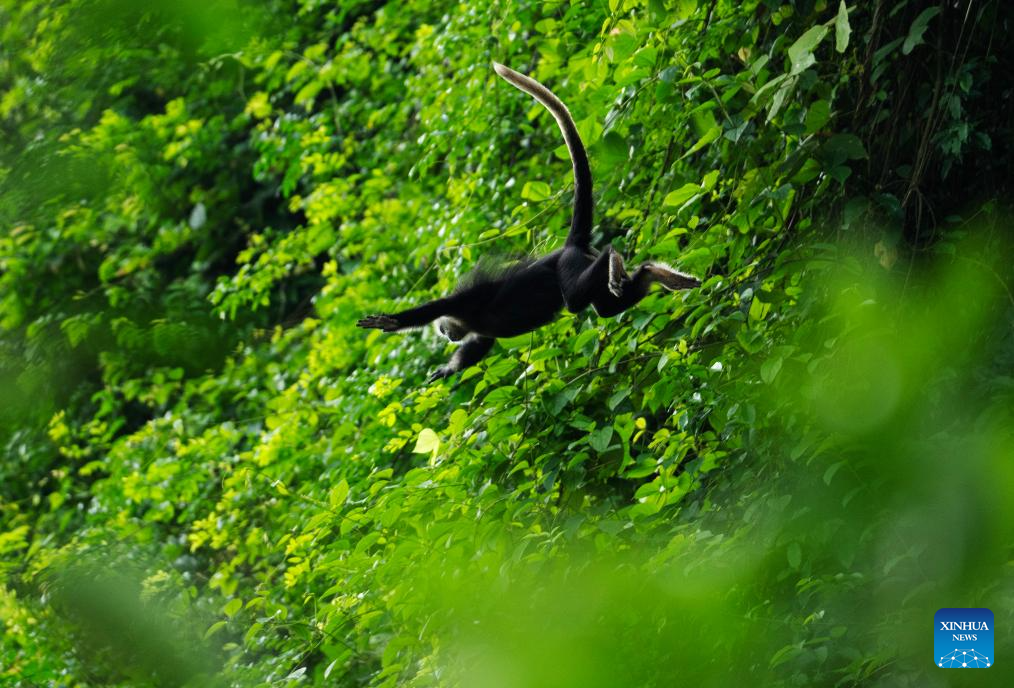
A white-headed langur leaps at a national nature reserve in Luobai Town of Jiangzhou District, Chongzuo City, south China's Guangxi Zhuang Autonomous Region, Aug. 5, 2023. China's white-headed langur is one of the world's most endangered primate species. Characterized by the white hair on their heads, the animals are spotted in less than 200 square km karst hills between the Zuojiang and Mingjiang rivers in Chongzuo.
In recent years, in order to better protect the white-headed langur, patrolling and technological measures including infrared cameras and remote monitoring have been applied to track and monitor them around the clock. The latest figures show that the population of white-headed langurs has increased to about 1,400 thanks to a group of guardians who dedicate themselves to protecting those "elves" in spite of many difficulties. (Xinhua/Fei Maohua)
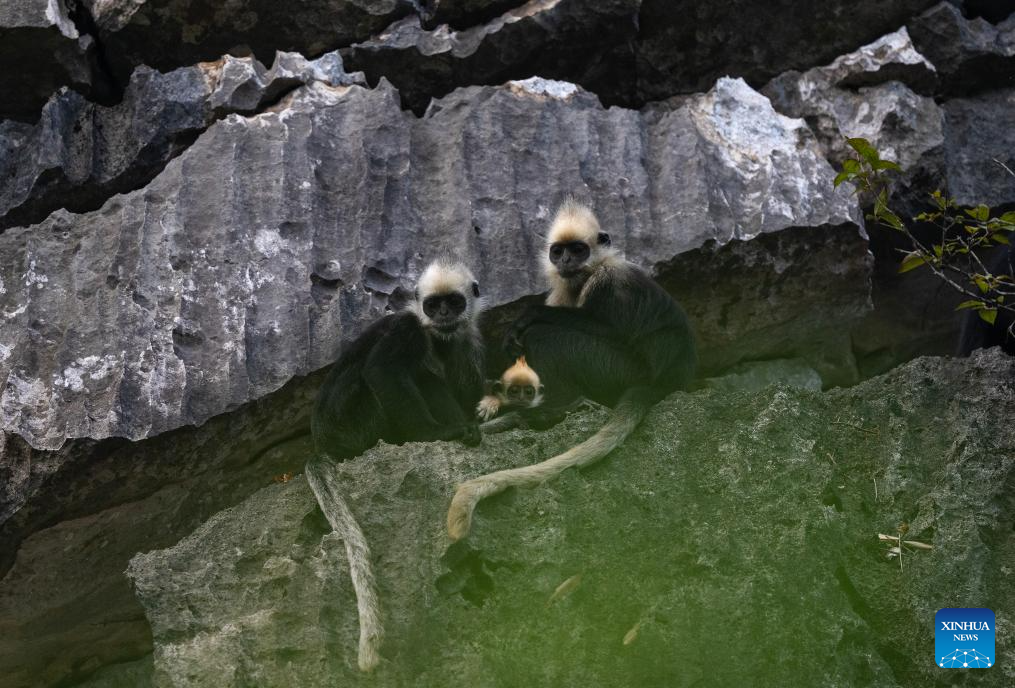
Three white-headed langurs rest on a cliff at a national nature reserve in Luobai Town of Jiangzhou District, Chongzuo City, south China's Guangxi Zhuang Autonomous Region, Aug. 5, 2023. China's white-headed langur is one of the world's most endangered primate species. Characterized by the white hair on their heads, the animals are spotted in less than 200 square km karst hills between the Zuojiang and Mingjiang rivers in Chongzuo.
In recent years, in order to better protect the white-headed langur, patrolling and technological measures including infrared cameras and remote monitoring have been applied to track and monitor them around the clock. The latest figures show that the population of white-headed langurs has increased to about 1,400 thanks to a group of guardians who dedicate themselves to protecting those "elves" in spite of many difficulties. (Xinhua/Fei Maohua)

Researcher Li Wenqin (R) and Liu Yanchen observe white-headed langurs at a national nature reserve in Luobai Town of Jiangzhou District, Chongzuo City, south China's Guangxi Zhuang Autonomous Region, Aug. 5, 2023. China's white-headed langur is one of the world's most endangered primate species. Characterized by the white hair on their heads, the animals are spotted in less than 200 square km karst hills between the Zuojiang and Mingjiang rivers in Chongzuo.
In recent years, in order to better protect the white-headed langur, patrolling and technological measures including infrared cameras and remote monitoring have been applied to track and monitor them around the clock. The latest figures show that the population of white-headed langurs has increased to about 1,400 thanks to a group of guardians who dedicate themselves to protecting those "elves" in spite of many difficulties. (Xinhua/Li Mengxin)

Tourists view white-headed langurs at a national nature reserve in Luobai Town of Jiangzhou District, Chongzuo City, south China's Guangxi Zhuang Autonomous Region, Aug. 5, 2023. China's white-headed langur is one of the world's most endangered primate species. Characterized by the white hair on their heads, the animals are spotted in less than 200 square km karst hills between the Zuojiang and Mingjiang rivers in Chongzuo.
In recent years, in order to better protect the white-headed langur, patrolling and technological measures including infrared cameras and remote monitoring have been applied to track and monitor them around the clock. The latest figures show that the population of white-headed langurs has increased to about 1,400 thanks to a group of guardians who dedicate themselves to protecting those "elves" in spite of many difficulties. (Xinhua/Li Mengxin)
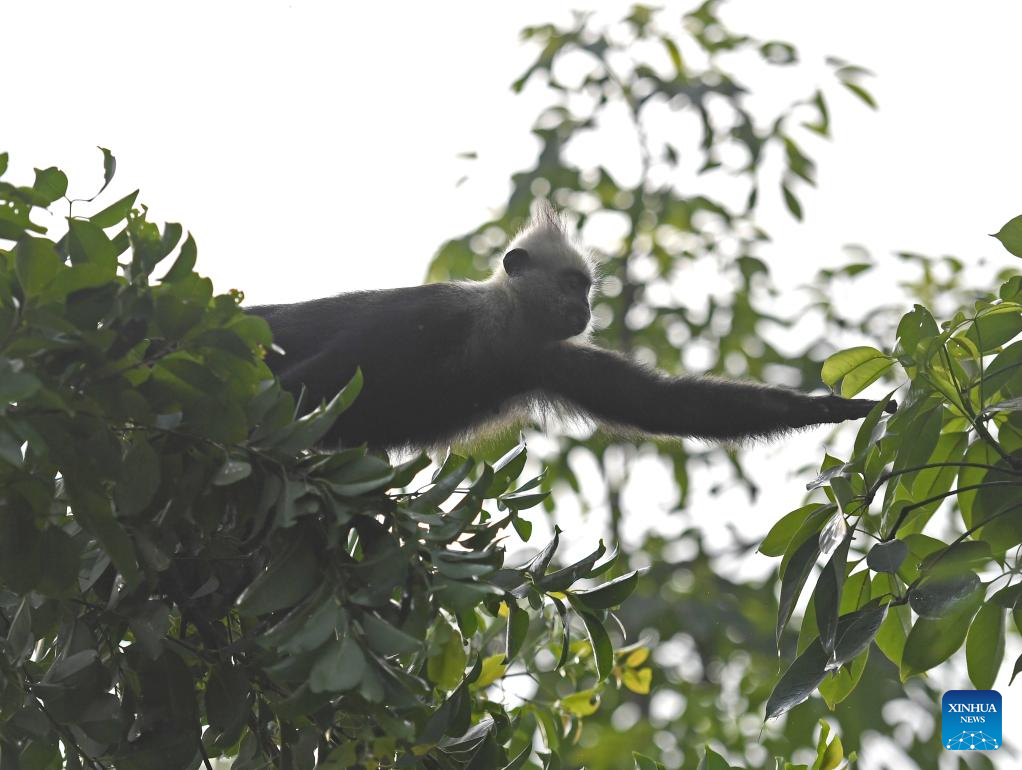
A white-headed langur forages at a national nature reserve in Luobai Town of Jiangzhou District, Chongzuo City, south China's Guangxi Zhuang Autonomous Region, Aug. 5, 2023. China's white-headed langur is one of the world's most endangered primate species. Characterized by the white hair on their heads, the animals are spotted in less than 200 square km karst hills between the Zuojiang and Mingjiang rivers in Chongzuo.
In recent years, in order to better protect the white-headed langur, patrolling and technological measures including infrared cameras and remote monitoring have been applied to track and monitor them around the clock. The latest figures show that the population of white-headed langurs has increased to about 1,400 thanks to a group of guardians who dedicate themselves to protecting those "elves" in spite of many difficulties. (Xinhua/Zhou Hua)

Researcher Li Wenqin (C) and Liu Yanchen and ranger Liang Zhizhang (R) observe white-headed langurs at a national nature reserve in Luobai Town of Jiangzhou District, Chongzuo City, south China's Guangxi Zhuang Autonomous Region, Aug. 5, 2023. China's white-headed langur is one of the world's most endangered primate species. Characterized by the white hair on their heads, the animals are spotted in less than 200 square km karst hills between the Zuojiang and Mingjiang rivers in Chongzuo.
In recent years, in order to better protect the white-headed langur, patrolling and technological measures including infrared cameras and remote monitoring have been applied to track and monitor them around the clock. The latest figures show that the population of white-headed langurs has increased to about 1,400 thanks to a group of guardians who dedicate themselves to protecting those "elves" in spite of many difficulties. (Xinhua/Zhou Hua)

Researcher Li Wenqin (back) and Liu Yanchen observe white-headed langurs at a national nature reserve in Luobai Town of Jiangzhou District, Chongzuo City, south China's Guangxi Zhuang Autonomous Region, Aug. 5, 2023. China's white-headed langur is one of the world's most endangered primate species. Characterized by the white hair on their heads, the animals are spotted in less than 200 square km karst hills between the Zuojiang and Mingjiang rivers in Chongzuo.
In recent years, in order to better protect the white-headed langur, patrolling and technological measures including infrared cameras and remote monitoring have been applied to track and monitor them around the clock. The latest figures show that the population of white-headed langurs has increased to about 1,400 thanks to a group of guardians who dedicate themselves to protecting those "elves" in spite of many difficulties. (Xinhua/Fei Maohua)

Researcher Li Wenqin cleans mud from his sole at a national nature reserve in Luobai Town of Jiangzhou District, Chongzuo City, south China's Guangxi Zhuang Autonomous Region, Aug. 5, 2023. China's white-headed langur is one of the world's most endangered primate species. Characterized by the white hair on their heads, the animals are spotted in less than 200 square km karst hills between the Zuojiang and Mingjiang rivers in Chongzuo.
In recent years, in order to better protect the white-headed langur, patrolling and technological measures including infrared cameras and remote monitoring have been applied to track and monitor them around the clock. The latest figures show that the population of white-headed langurs has increased to about 1,400 thanks to a group of guardians who dedicate themselves to protecting those "elves" in spite of many difficulties. (Xinhua/Fei Maohua)
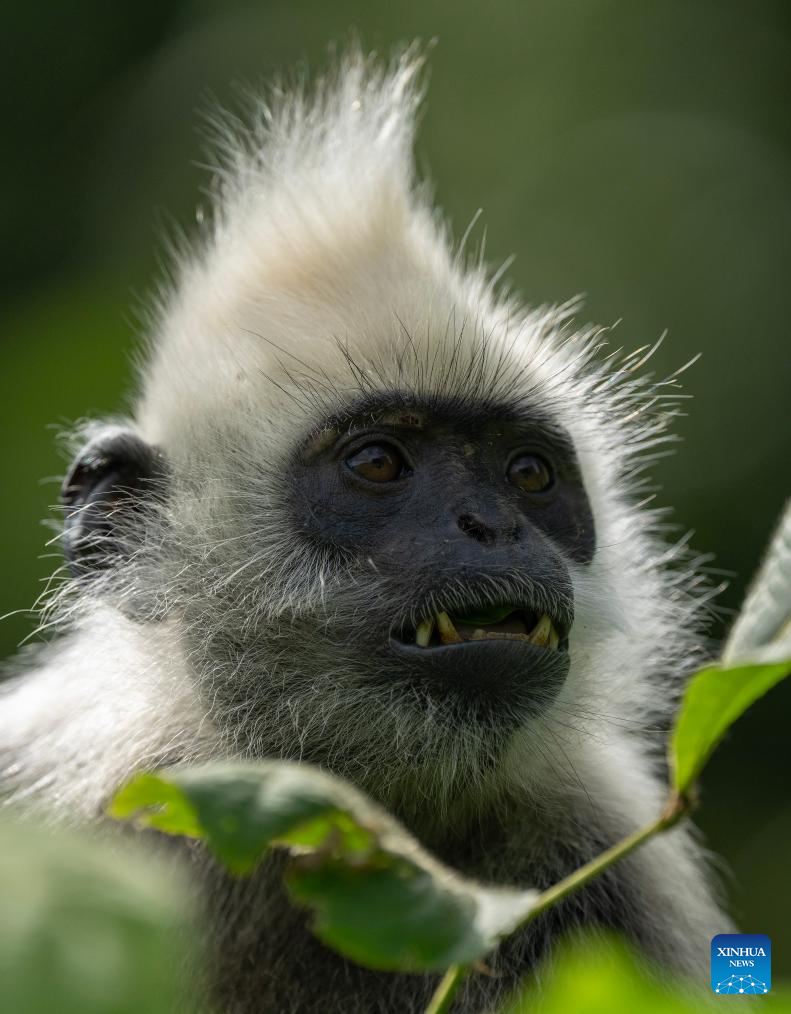
A white-headed langur is pictured at a national nature reserve in Luobai Town of Jiangzhou District, Chongzuo City, south China's Guangxi Zhuang Autonomous Region, Aug. 5, 2023. China's white-headed langur is one of the world's most endangered primate species. Characterized by the white hair on their heads, the animals are spotted in less than 200 square km karst hills between the Zuojiang and Mingjiang rivers in Chongzuo.
In recent years, in order to better protect the white-headed langur, patrolling and technological measures including infrared cameras and remote monitoring have been applied to track and monitor them around the clock. The latest figures show that the population of white-headed langurs has increased to about 1,400 thanks to a group of guardians who dedicate themselves to protecting those "elves" in spite of many difficulties. (Xinhua/Fei Maohua)

Ranger Liang Zhizhang cuts down bushes with a machete to make way during a patrol at a national nature reserve in Luobai Town of Jiangzhou District, Chongzuo City, south China's Guangxi Zhuang Autonomous Region, Aug. 4, 2023. China's white-headed langur is one of the world's most endangered primate species. Characterized by the white hair on their heads, the animals are spotted in less than 200 square km karst hills between the Zuojiang and Mingjiang rivers in Chongzuo.
In recent years, in order to better protect the white-headed langur, patrolling and technological measures including infrared cameras and remote monitoring have been applied to track and monitor them around the clock. The latest figures show that the population of white-headed langurs has increased to about 1,400 thanks to a group of guardians who dedicate themselves to protecting those "elves" in spite of many difficulties. (Xinhua/Fei Maohua)
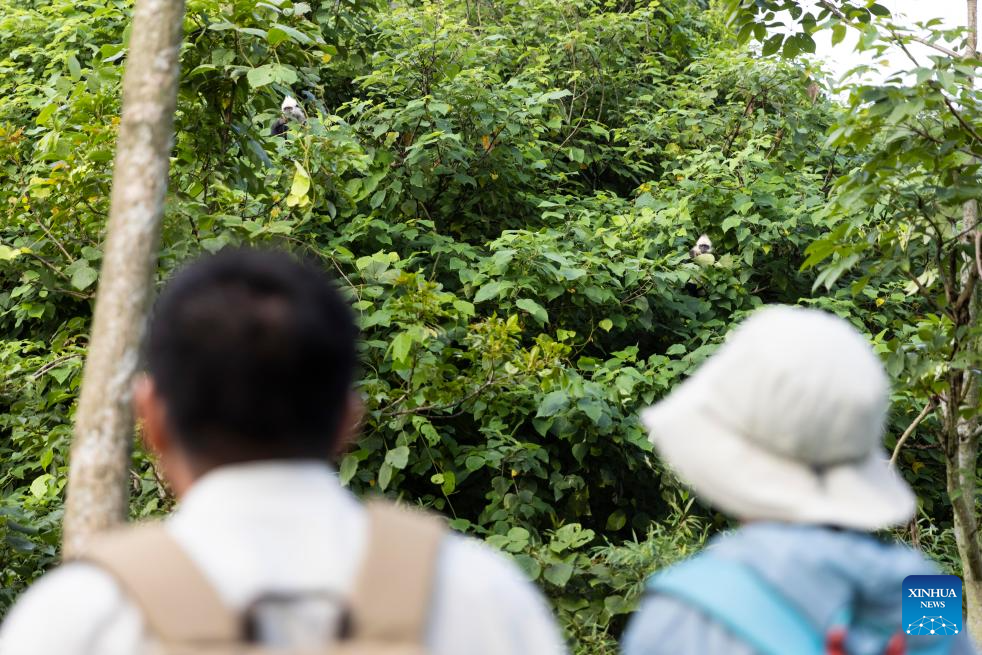
Researcher Li Wenqin (R) and ranger Liang Zhizhang observe white-headed langurs at a national nature reserve in Luobai Town of Jiangzhou District, Chongzuo City, south China's Guangxi Zhuang Autonomous Region, Aug. 5, 2023. China's white-headed langur is one of the world's most endangered primate species. Characterized by the white hair on their heads, the animals are spotted in less than 200 square km karst hills between the Zuojiang and Mingjiang rivers in Chongzuo.
In recent years, in order to better protect the white-headed langur, patrolling and technological measures including infrared cameras and remote monitoring have been applied to track and monitor them around the clock. The latest figures show that the population of white-headed langurs has increased to about 1,400 thanks to a group of guardians who dedicate themselves to protecting those "elves" in spite of many difficulties. (Xinhua/Li Mengxin)
点击右上角![]() 微信好友
微信好友
 朋友圈
朋友圈

请使用浏览器分享功能进行分享
